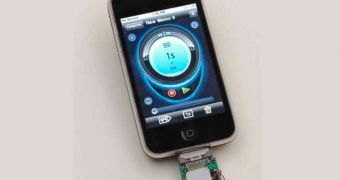Smartphones are already an indispensable commodity to a lot of people, and have become an integrated part of their daily lives. Some use them to surf the Web and post updates on Facebook and Twitter, while others use facilities such as document viewers and editor, and slideshow presentations. But now, researchers at the NASA Ames Research Center, in California, have developed a new chemical sensor, which can be readily connected to an iPhone, and controlled via a dedicated software. These devices are perfectly able to detect chemical threats, and experts want to make them work in massive grids.
That is to say, analysis data collected from a single smartphone could be correlated with thousands of other sets, collected from other devices, either in the same area or across the state. This would allow authorities to always have a clear picture of which areas are the most contaminated, and which pose the highest degree of danger to public health. First responders after a natural calamity could also be alerted by the very smartphones of the people they are trying to save from the potential release of dangerous chemicals from broken pipes and so on, LiveScience reports.
According to the experts who developed the technology, the new sensors are perfectly able of detect trace amounts of ammonia, chlorine gas, and methane, which are all very hazardous to human health. The results of the measurements can be sent to other phones directly, so as to warn their users, or to central computers, which would in turn alert authorities. The information packages could be sent over “classic” telephone networks, or over Wi-Fi ones. At the core of the technology is an array of 64 nanosensors, all of which are very small, cheap, and fast in their detection.
The Ames research group, led by physical scientist Jing Li, is currently scheduled to begin Phase II of the project, in which it will advance the capabilities of the nanosensors to a point where the small devices would become able to displaying concentrations of dangerous chemicals directly on the telephone screen. At this point, a computer is necessary to display the collected data. The humidity and temperature of the environment where the data is collected are also a target for the researchers, and they plan to devise sensors capable of picking that up as well. The built-in GPS feature of the iPhone and other smartphones could also be used to ease emergency response.

 14 DAY TRIAL //
14 DAY TRIAL //